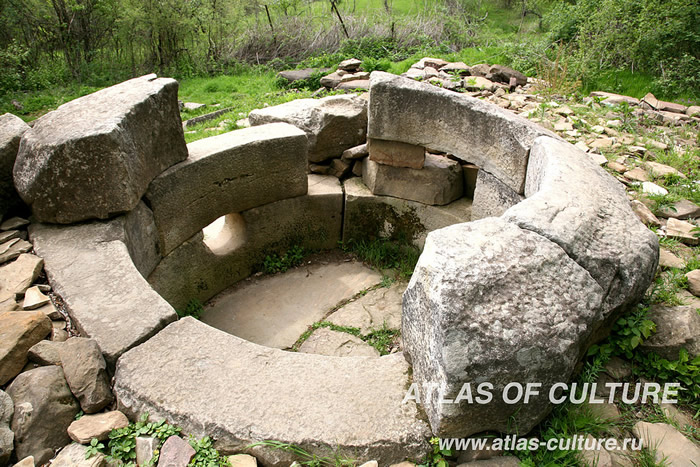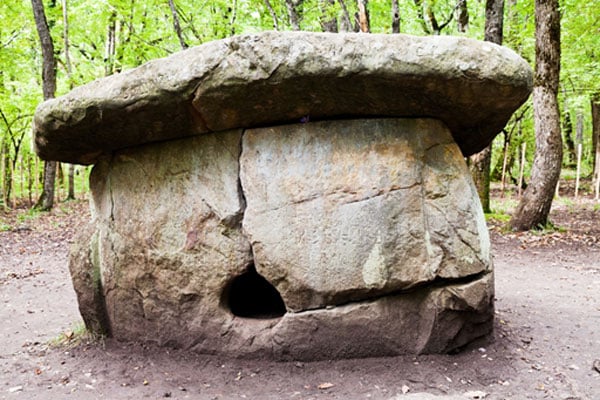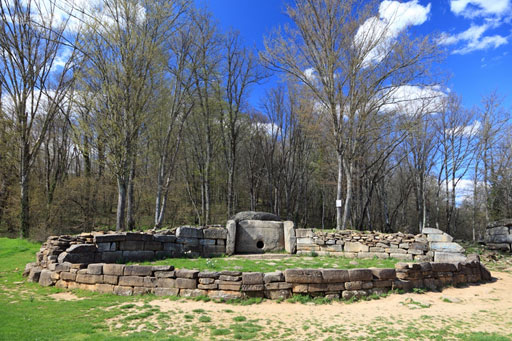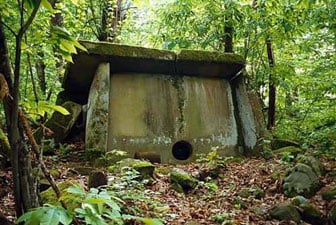The Mysterious Dolmens of the Caucasus

The Western Caucasus, extending over 275,000 ha of the extreme western end of the Caucasus mountains and located 50 km north-east of the Black Sea, is one of the few large mountain areas of Europe that has not experienced significant human impact. Yet dotted within the pristine landscape are thousands of ancient megalithic structures built many millennia ago. Archaeologists do not know who built them, where the stones came from, or what their true purpose was, leading to much speculation in the scientific community.

The Russians call the megalithic structures dolmens, which means ‘portal tomb’, but despite the name, there is no solid evidence that their original purpose was for burial. Archaeologists put their age at 4000 to 6,000 years old, based on pottery found in the vicinity of the dolmens, as well as human remains, but there is no way to prove whether these were put there much later.
While there are tens of thousands of known dolmens throughout the world, particularly throughout Europe, the Caucasian dolmens represent a unique type of prehistoric architecture, built with precisely dressed cyclopic stone blocks. The stones were, for example, shaped into 90-degree angles, to be used as corners, and all of them are punctuated with a portal in the centre of the facade. While round holes are the most common, square ones have also been found. Stone plugs have been found at almost every tomb, and were used to block the portal at the front.

Most of the Caucasian dolmens contain an almost perfectly formed circle at the front. Photo source.
In front of the facade is a court that usually extends out, creating an area where rituals are believed to have taken place. The court is usually outlined by large stone walls, sometimes over a meter high. It is in this area that Bronze and Iron Age pottery has been found, along with human remains, bronze tools, and ornaments made from silver, gold, or precious stones.

Dolmen surrounded by stone wall, forming a centre court. Photo source: BigStockPhoto
Approximately 3,000 of these megalithic monuments are known in the Western Caucasus, but more are constantly being found. The average weight of each structure is from 15 to 30 tons, yet there is not even the slightest trace of a quarry in the Western Caucasus, nor have any paths been found with evidence of heavy loads having been brought to the build site. The construction itself is also awe-inspiring. Within most of the dolmens, the huge stone plates join each other precisely with specially made grooves. The joint places are so close in places that it is impossible to even slide a knife blade between the plates. In 2007, it was decided to reconstruct a dolmen from the stones plates of destroyed structures in Gelendzhik and carry out the processing and fitting with high-precision electric tools. Despite the help of modern technology, the builders were unable to achieve the same level of precision as the Bronze Age builders.

Caucasian dolmen displaying straight and precise edges and joints, and a perfectly formed circle in the centre. Photo source.
So, who were these people who achieved such precision in construction? According to the Vladimir Markovin, an archaeologist who has devoted much of his life to studying the Caucasian dolmens, the people of the time lived in mud huts, had no knowledge of iron or the pottery wheel, and cultivated land with hoes. Yet they still had constructions, whose design is impressive, even by modern standards.
Many locals will tell you the legend of the dwarves who once settled in the area; people who were so tiny that they used hares for riding. And, just like in fairy tales, they lived alongside giants who built stone dwellings for their feeble neighbours so that they could take shelter in bad weather. However, the giants were not repaid for their kindness. In order to tame the giants, the little people blinded them and gave them mind-altering herbs. The giants began to lose their minds and unleashed war and carnage, resulting in mass extinction of both the dwarves and the giants, with only the stone houses remaining.

According to legend, the houses were built by giants for a race of little people who lived inside them. Photo source: BigStockPhoto
Archaeologists have put forward two main hypotheses regarding the purpose of the dolmens. The first is that they were places of tribal worship. The second is that they were burial places. During the excavation, many of them contained burial sites of people who had lived during different historical periods, and next to them were various items that indicate belief in an afterlife. However, many researchers argue that the burials constitute secondary use and were not the original reason for their construction.
Today, many of the dolmens are in great disrepair and will be completely lost if they are not protected from vandals and general neglect. It is hoped that the ancient megaliths may be preserved long enough to one day unlock their secrets.
Related Post
A shocking documentary proves that mermaids do exist
SHOCKING Revelation: Thuya, Mother of Queen Tiye, Was the Grandmother of Akhenaten and Tutankhamun—What Ancient Egyptian Secrets Did She Leave Behind?
Breaking News: Astonishing Discoveries at Karahan Tepe Confirm an Extraterrestrial Civilization is Hiding on Earth, and NO ONE Knows!
Breaking News: Researchers FINALLY Discover U.S. Navy Flight 19 After 75 Years Lost in the Bermuda Triangle!
NASA’s Secret Investigation: Uncovering the Astonishing Mystery of the UFO Crash on the Mountain!
Explosive UFO Docs LEAKED: Startling Proof That Aliens Ruled Ancient Egypt!